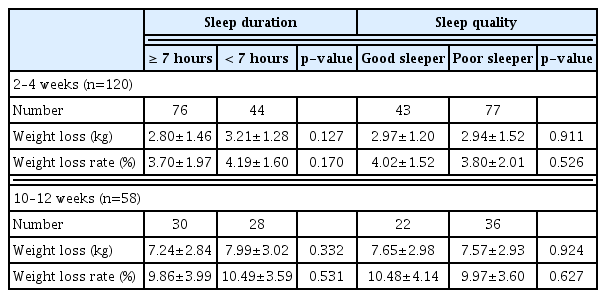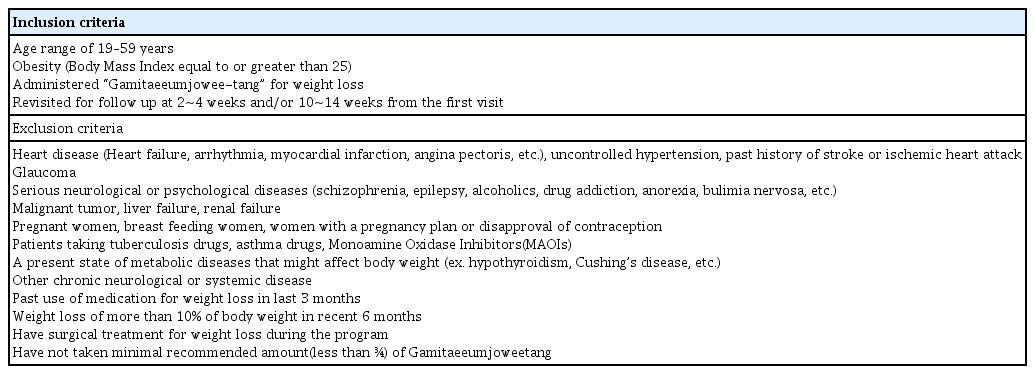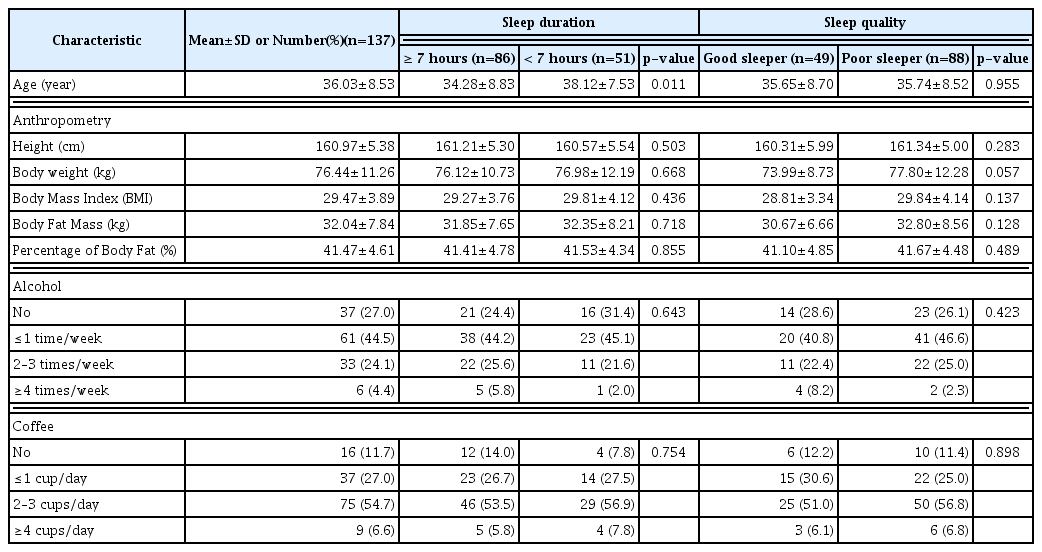References
1. Hill JO, Wyatt HR, Peters JC. Energy balance and obesity. Circulation 2012;126(1):126–32.
2. Kim MK, Lee WY, Kang JH, Kang JH, Kim BT, Kim SM, et al. Clinical practice guidelines for overweight and obesity in Korea. Endocrinology and Metabolism 2014;29(4):405–9.
4. Korean Society for the Study of Obesity. Treatment guideline of obesity 2012 Seoul: Korean Society for the Study of Obesity; 2012.
5. Buxton OM, Marcelli E. Short and long sleep are positively associated with obesity, diabetes, hypertension, and cardiovascular disease among adults in the United States. Social science & medicine 2010;71(5):1027–36.
6. Coughlin JW, Smith MT. Sleep, obesity, and weight loss in adults: Is there a rationale for providing sleep interventions in the treatment of obesity? Int Rev Psychiatry 2014;26(2):177–88.
7. Bonanno L, Metro D, Papa M, Finzi G, Maviglia A, Sottile F, et al. Assessment of sleep and obesity in adults and children: Observational study. Medicine 2019;98(46):e17642.
8. Jeong KS, Lee SW, Kim Hs, Baek YH. The association between sleep duration, sleep quality and obesity according to Sasang constitution. J Sasang Constitut Med 2017;29(1):40–9.
9. Nam SH, Kim SY, Lim YW, Park YB. Review on Predictors of Weight Loss in Obesity Treatment. J Korean Med Obes Res 2018;18(2):115–27.
10. Kang EY, Park YB, Kim MY, Park YJ. A study on factors associated with weight loss by ‘Gamitaeeumjowee-tang’. J Korean Med Obes Res 2017;17(2):68–76.
11. Mong JA, Cusmano DM. Sex differences in sleep: impact of biological sex and sex steroids. Philosophical Transactions of the Royal Society B: Biological Sciences 2016;371:1688. 20150110.
12. Sohn SI, Kim DH, Lee MY, Cho YW. The reliability and validity of the Korean version of the Pittsburgh Sleep Quality Index. Sleep and Breathing 2012;16(3):803–12.
14. Buysse DJ, Reynolds CF III, Monk TH, Berman SR, Kupfer DJ. The Pittsburgh Sleep Quality Index: a new instrument for psychiatric practice and research. Psychiatry Res 1989;28(2):193–213.
15. Han KS, Lee MJ, Kim HJ. Systematic review on herbal treatment for obesity in adults. J Korean Med Rehabil 2016;26(4):23–35.
16. Hur HS, Kang OS. A review study of treatments for Taeeumin obesity. J Sasang Constitut Med 2019;31(4):28–40.
17. Seo NJ, Nam DW, Lee EO, Shim BS, Ahn KS, Kim SH. Clinical study of Gamitaeeumjowi-tang for obese patients. Korean J Oriental Physiology & Pathology 2008;22(2):446–52.
18. Yoon NR, Yoo YJ, Kim MJ, Kim SY, Lim YW, Lim HH, Park YB. Analysis of adverse events in weight loss program in combination with ‘Gamitaeeumjowee-Tang’ and low-calorie diet. J Korean Med Obes Res 2018;18(1):1–9.
19. Li JE, Song YK, Lim HH. Clinical trial of Taeeumjowui-Tang(Taiyintiaowei-tang) on obese patients - randomized, double blind, placebo-controlled study-. J Oriental Rehab Med 2010;20(4):197–213.
20. Filiatrault ML, Chaput JP, Drapeau V, Tremblay A. Eating behavior traits and sleep as determinants of weight loss in overweight and obese adults. Nutrition & diabetes 2014;4(10):e140.
21. Wang X, Sparks JR, Bowyer KP, Youngstedt SD. Influence of sleep restriction on weight loss outcomes associated with caloric restriction. Sleep 2018;41(5):zsy027.
22. Thomson CA, Morrow KL, Flatt SW, Wertheim BC, Perfect MM, Ravia JJ, Sherwood NE, Karanja N, Rock CL. Relationship between sleep quality and quantity and weight loss in women participating in a weight-loss intervention trial. Obesity 2012;20(7):1419–25.
23. Elder CR, Gullion CM, Funk KL, DeBar LL, Lindberg NM, Stevens VJ. Impact of sleep, screen time, depression and stress on weight change in the intensive weight loss phase of the LIFE study. Int J Obes 2012;36(1):86–92.
24. O’Brien EM, Fava J, Subak LL, Stone K, Hart CN, Demos K, Wing R. Sleep duration and weight loss among overweight/obese women enrolled in a behavioral weight loss program. Nutrition & diabetes 2012;2(9):e43.
25. Reed JR, Yates BC, Houfek J, Briner W, Schmid KK, Pullen CH. Motivational factors predict weight loss in rural adults. Public Health Nurs 2016;33(3):232–41.
26. Lee YH, Go NG, Min DL. Retrospective study about the effectiveness of Korean medicine treatment on 254 patients visited obesity clinic. J Korean Med Obes Res 2015;15(1):33–7.
27. Coughlin JW, Smith MT. Sleep, obesity, and weight loss in adults: Is there a rationale for providing sleep interventions in the treatment of obesity? Int Rev Psychiatry 2014;26(2):177–88.
29. Song MY, Kim HJ, Lee MJ. The safety guidelines for use of Ma-huang in obesity treatment. J Korean Med Obes Res 2006;6(2):17–27.
30. Song YK, Lim HH. Clinical application of Ma Huang in the obesity treatment. J Korean Med Obes Res 2007;7(1):1–7.





